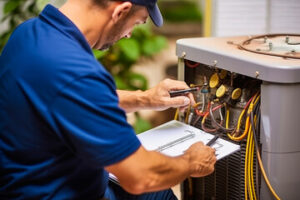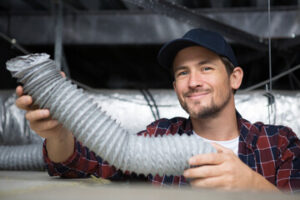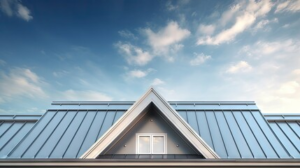The first step in installing an air conditioner is to evaluate your house’s cooling infrastructure. This evaluation includes a Manual J load calculation and can help determine which size unit is suitable for your home.

Installers then push the unrolled line set through a hole in the wall near the AC, ensuring enough line is pushed out to reach the service valve. This process can take up to an hour. Contact Air Conditioning Installation Milford OH for more information.
During the outdoor unit installation, the technicians will start by clearing the work area. This may include moving rugs, toys, and other furniture to allow for clear access to the air conditioning system. It is important to do this to minimize the chance of property damage as well as prevent accidents or injuries that can occur during the process. It is also helpful to have a path cleared that leads from the entrance of your home to the work area so the contractors can move around without obstruction.
After securing the work area, the installers will begin by taking apart the old outdoor unit. This includes removing the copper refrigerant lines that connect from the indoor evaporator coil to the outside compressor. These will be replaced with new, high quality pipes that are designed to last the life of your system. Next, the outdoor unit will be set on a new composite pad. This will provide a level surface that can withstand vibration and other stresses. Then, the copper refrigerant lines will be connected to the new outdoor unit and attached with special fittings to prevent leaks.
Can the air conditioner outdoor unit be placed higher than the indoor unit?
There are several ways to install an air conditioning system, including a traditional split system that has one outdoor unit and multiple indoor units. Other systems, like ductless mini-splits, have separate evaporator and fan units for each room of the home or building. Regardless of which system is installed, the distance between the indoor and outdoor units should not be too far because this will affect its performance.
The technician will then choose a place on the exterior wall to drill a hole for the pipes that will connect the indoor and outdoor units. They will carefully make sure that there are no wires or pipes in the way of this location before drilling. Then they will drill a hole that is approximately 7-8 cm in diameter.
Once the hole is ready, the electrician will then attach the line set. During this process, they will unroll a section of the tube and then push it through the hole that has been drilled in the wall. This will be done until enough of the tube is out to reach the service valve on the outdoor unit.
Installing the Indoor Unit
When the time comes to install the indoor unit, you must first select a location. This is where the air conditioner will be mounted in your home. It should be located away from bedrooms and living areas to avoid disturbing your sleep or causing noise problems. It should also be easily accessible to technicians from your AC installation company for servicing and cleaning. Finally, the unit must be properly insulated and sealed to protect it from leaks and pests.
Once the location is chosen, a hole is drilled through the wall of the house to feed the copper piping and cable. This is done by using a kit that comes with a drill and the appropriate bits. Expanding polyurethane foam is then sprayed into the holes to seal them.
The installer then mounts the indoor unit into the window frame. He may use screws or brackets to secure it in place. The unit should be installed a minimum of 3.3 feet away from antennas, power lines used for television or radio, home security systems, intercoms, and telephones. This will prevent electrical interference that could cause problems with the system.
Next, the suction and liquid lines are installed. These are made from soft copper and are placed close to beams and ductwork in paths with as few bends as possible. The installer will then connect them to the air conditioning and vacuum the lines before adding refrigerant. He will take special care not to kink or damage the lines.
Before the installer arrives, make sure you clear a path to the work area of any furniture or other obstacles. This minimizes the risk of property damage and accidents during the installation process. During this visit, the installer should also go over proper operation and maintenance of your new air conditioner.
Before the installation team leaves your home, they should give you a call or text to let you know that they are on their way. Many companies will also send pictures and bios of the team that will be working on your home ahead of time. This provides added peace of mind for you and your family and will allow you to feel comfortable letting strangers into your home.
Installing the Ductwork
Whether you’re replacing your current air conditioning system or installing it in an older home, the ductwork is a vital component. It transports heated or cooled air throughout your house, so it’s important that the ducts are properly configured and sealed to avoid leakage and loss of efficiency. HVAC experts can evaluate your ducts and provide tips for improvement.
If you’re installing a new AC in an existing home, the first step is to determine how much cooling capacity your system will need. This is done with a load calculation test. Then, a diagram is drawn to show the locations of the rooms that will be served. This helps the HVAC installer choose the size of air conditioner and ducts necessary to meet your home’s cooling requirements.
Once the ductwork is in place, the air flow from the air conditioning unit can be directed through the return and supply trunk lines into the conditioned space. The ducts can be made of metal or flexible fiberglass, depending on your needs and budget. Both materials can be long-lasting if installed correctly. However, metal ducts can be more durable and easier to maintain than flexible ducts.
The airflow through the ducts is optimized by keeping the longest runs as short as possible. The number of bends in a duct also affects airflow. Too many bends can reduce the amount of cooling that reaches a room and force the system to work harder. Airflow can also be obstructed by poorly fastened joints and leaks.
The best ductwork is well-insulated and sealed, and the vents should be secured to the walls. The ductwork should be checked for proper installation and connections before the air conditioning system is turned on for commissioning. This will ensure everything is working as it should, and will save you time and money in the future. If you have any questions about ductwork or are interested in air conditioning installation, contact the professionals at Sewell Electric & HVAC. They’ve been in business for over 70 years and know how to get the job done right.
Installing the Compressor
The compressor is the heart of your air conditioning system. Without it, you can’t have cool air. When your compressor isn’t working properly, it can cause a variety of issues such as loud noises, excessive vibration, and even failure. It’s important to recognize signs of a failing compressor so that you can take the proper steps to replace it.
Changing a compressor can be an involved process. There are multiple things to keep in mind, from ensuring that the system is clean and properly evacuated to using the correct type and amount of lubricant for the new compressor.
To start, the system must be evacuated and the compressor must be removed from the unit. During this process, the team will use a refrigerant recovery machine to remove the existing refrigerant from the system. This is important, as it is illegal to vent refrigerant into the atmosphere. The refrigerant will then be drained into an approved container. This step will also include disconnecting electrical wire connections, removing the crank case heater (if there is one), and installing a new compressor disconnect box if the old system didn’t have one.
After the existing compressor is removed, the new compressor will be bolted to the condenser unit. A new receiver drier, orifice tube, and expansion valve will also be installed. Once the new parts are in place, the ac contractor will reattach the refrigerant lines and connect the electrical connectors. The system will then be charged with the recovered refrigerant.
It’s also important that the ac installer takes the time to properly test and commission the system. This is the only way to ensure that your new air conditioner is functioning properly. It’s not uncommon for companies to simply turn the system on and walk away once it is in operation, but proper commissioning requires specialized training and equipment. It’s a necessary step to ensure that the system is running correctly, which will help to reduce energy costs and increase comfort levels in your home.



